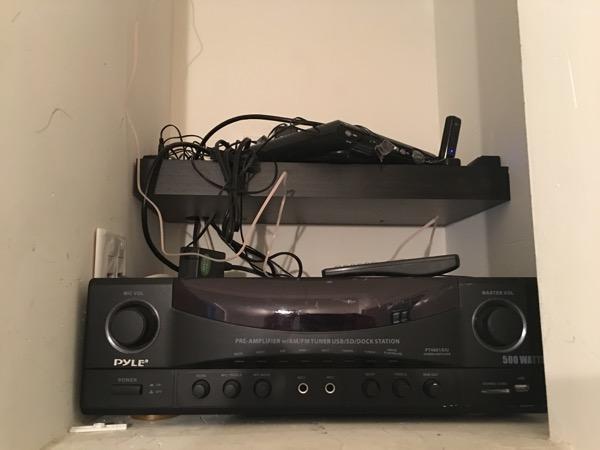I'm sure CEDIA is a fantastic convention, with the latest and greatest gear. However, professional installers (or the new catch word 'Integrator') are mostly superfluous to us "cheap folks" (regular working Joe).
Now, if I had $100,000 for a whole home A/V install or even for a state of the art dedicated Home Theater space, then a 'Certified Integrator' would be a must.
Sure, Anyone Could Do It. But Do You Want Them To?
I’m not dissing on the use of the all(and I mean all)-in-one “500 Watt Stereo Receiver AM-FM Tuner/USB/SD/iPod Docking Station & Subwoofer Control” Pyle PT4601AIU HYBRID AMPLIFIER. (MSRP of $277.99 but available online for $95.40 via this link found on Pyle’s website or $87.68 (at the moment) from Amazon.) For all I know, it might be the world’s greatest “500 Watt Stereo Receiver AM-FM Tuner/USB/SD/iPod Docking Station & Subwoofer Control”, worthy of five stars across the board and a Top Pick Award. (Amazon customers gave it a 3.3 out of 5 rating.) We haven’t taken used it yet, and I doubt we’ll be here long enough to do so. Considering the nature of the convention we’re here to cover (CEDIA 2017), though, I couldn’t help but notice the slipshod manner in which the gear had been installed.
If the tangled jumble of wires isn’t enough to make you shake your head in disappointment, the fact that there are only two components in this “system” should make you cringe with disgust. Even the dipole FM antenna was kind of haphazardly strung across the gear and then stuck to the wall (just out of the photo) with a piece of blue painter’s tape.
I’m guessing that this part of the system—the rest of the wires disappear into the wall through a wall plate behind the gear—wasn’t installed by a CEDIA-certified integrator. I’m sure the rental property owners saved a little bit of money by either doing it themselves (unlikely) or having someone in their maintenance crew install it (likely). As so often happens when you try to cut corners, this will probably end up being penny wise but dollar foolish.
For starters, there’s the obvious bad impression this makes on anyone renting the property when/if they see the poor state of the gear’s installation. I doubt it’ll cause anyone to decide not to rent the place in the future, but it does take the edge off of an otherwise cozy and comfortable appearance. Potentially more problematic, however, is the fact that this system is precariously on the edge of failing to operate properly—if at all. Should a visitor decide to use the built-in iPod dock mounted on top of the feature-burdened Pyle AVR, it’s extremely likely that wires will get moved, and randomly moving wires in a system is never a good thing. That IR emitter on the AT&T U-verse box looks like its ready to pop off with just the slightest of provocations. (The IR emitter on the TV in the adjacent room is already detached and hanging off the TV’s bezel.)
A non-working AV system is a much bigger problem than an ugly bunch of wires and components hidden in a nook in a hallway. It’s likely to end up in a disgruntled call to the vacation rental company that’s responsible for taking care of the property. Even the quickest response and the best customer service by a maintenance person won’t wash all of the bad taste of the experience out of the renter’s proverbial mouth. Just as bad, though, is that one service call will probably wipe out most, if not all, of the money saved on the less-than-professional install—and, if the state of the installation isn’t brought up to professional standards, the whole customer-disappointing, money-wasting situation will, inevitably, happen again…and again.
The moral of the story is that hiring a professional, CEDIA-certified integrator is more expensive than doing it yourself, getting a friend to help out, or paying someone with minimal expertise a minimal amount of money to install a system isn’t the great deal that it may originally appear to be. AV integration and home automation requires both technical knowledge and skills the average “enthusiast” is not likely to possess. Since knowledge and skill are intangibles—unlike a piece hardware that you can see and hold in your hands—it’s tempting to skimp on them. But don’t. Carpenters often say, “Measure twice. Cut once.” When it comes to AV integration and home automation, here’s my advice: “Think twice. Pay once.” Eliminating hassles and disappointments ahead of time is priceless.
- Log in or register to post comments
















































